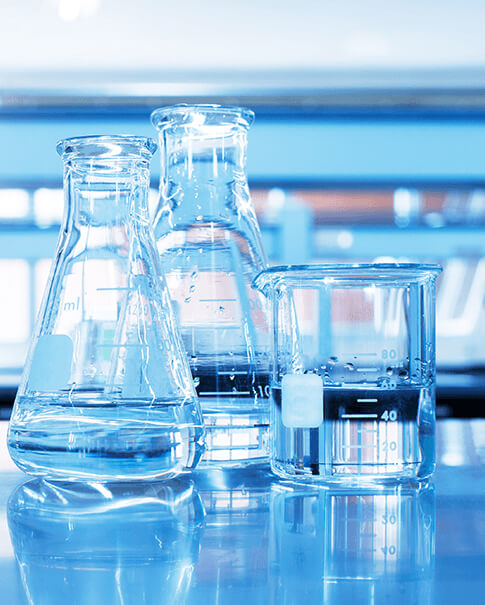
การเตรียมและคุณสมบัติของไฮโดรเจลนำไฟฟ้าโพลีอะคริลาไมด์
Nov 14, 2024ในการสังเคราะห์โพลีอะคริลาไมด์ที่มีน้ำหนักโมเลกุลสูง (PAM) คุณสามารถปฏิบัติตามวิธีการโพลิเมอไรเซชันแบบอนุมูลอิสระแบบดั้งเดิมได้ ต่อไปนี้เป็นขั้นตอน:
1. วัสดุที่ต้องการ: โมโนเมอร์อะคริลาไมด์ (AM) สารเชื่อมขวาง (เช่น N,N'-เมทิลีนบิซาคริลาไมด์) ตัวเริ่มต้นปฏิกิริยาอนุมูลอิสระ (เช่น แอมโมเนียมเพอร์ซัลเฟต) สารละลายบัฟเฟอร์ (เช่น Tris-HCl) อุปกรณ์โพลีเมอไรเซชัน (เช่น บีกเกอร์, แท่งคน และจานคน) แหล่งที่มาของก๊าซไนโตรเจน และอุปกรณ์ให้ความร้อน (เช่น อ่างน้ำ)
2. ติดตั้งอุปกรณ์โพลีเมอไรเซชันและเติมสารละลายบัฟเฟอร์ตามปริมาตรที่ต้องการ
3. เติมอะคริลาไมด์โมโนเมอร์และสารเชื่อมขวางในปริมาณที่จำเป็นลงในสารละลายบัฟเฟอร์ ความเข้มข้นของอะคริลาไมด์อาจแตกต่างกันไปขึ้นอยู่กับน้ำหนักโมเลกุลที่ต้องการของพอลิเมอร์
4. ละลายโมโนเมอร์และสารเชื่อมขวางให้หมดในสารละลายบัฟเฟอร์ขณะคนเบาๆ
5. เติมตัวเริ่มปฏิกิริยาอนุมูลอิสระ (เช่น แอมโมเนียมเพอร์ซัลเฟต) ลงในสารละลาย เพื่อให้มั่นใจว่ามีการกระจายตัวที่สม่ำเสมอ
6. ลดแก๊สสารละลายโดยการทำให้เกิดฟองก๊าซไนโตรเจนสักครู่หนึ่งเพื่อกำจัดออกซิเจนที่ละลายน้ำออก
7. วางสารละลายในอ่างน้ำหรืออุปกรณ์ทำความร้อนอื่นๆ เพื่อรักษาอุณหภูมิที่ต้องการสำหรับการเกิดปฏิกิริยาพอลิเมอไรเซชัน โดยทั่วไป การเกิดพอลิเมอไรเซชันจะดำเนินการที่อุณหภูมิประมาณ 50-70°C
8. การเกิดโพลีเมอไรเซชันจะเริ่มขึ้นหลังจากการเติมตัวริเริ่มไม่นาน ปล่อยให้ปฏิกิริยาดำเนินต่อไปตามระยะเวลาที่ต้องการเพื่อให้ได้น้ำหนักโมเลกุลที่ต้องการ เวลาปฏิกิริยาอาจแตกต่างกันไปขึ้นอยู่กับปัจจัยต่างๆ เช่น อุณหภูมิและความเข้มข้นของมอนอเมอร์
9. หลังจากเวลาปฏิกิริยาที่ต้องการ ให้หยุดการเกิดพอลิเมอไรเซชันโดยนำส่วนผสมของปฏิกิริยาออกจากเครื่องทำความร้อน หรือเติมสารดับ เช่น โซเดียมเมตาไบซัลไฟต์
10. ทำให้โพลีเมอร์ที่ได้ผลลัพธ์บริสุทธิ์โดยวิธีการต่างๆ เช่น การตกตะกอน การกรอง และการทำให้แห้ง
โปรดทราบว่าอะคริลาไมด์เป็นสารพิษต่อระบบประสาท และควรได้รับการจัดการด้วยความระมัดระวังในบริเวณที่มีการระบายอากาศดีหรือใต้ตู้ดูดควัน นอกจากนี้ การกำจัดของเสียจากปฏิกิริยาและผลพลอยได้ควรปฏิบัติตามกฎระเบียบด้านความปลอดภัยที่เหมาะสม
สิ่งสำคัญคือต้องสังเกตว่าการสังเคราะห์ของ โพลีอะคริลาไมด์ ควรปฏิบัติตามกฎหมาย ข้อบังคับ และขั้นตอนการจัดการที่ปลอดภัยในท้องถิ่น ขอแนะนำเสมอให้ศึกษาระเบียบปฏิบัติและการอ้างอิงเฉพาะ หรือขอคำแนะนำจากผู้เชี่ยวชาญที่มีความรู้ในการสังเคราะห์